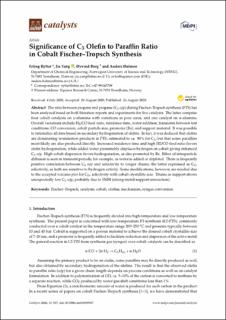| dc.description.abstract | The ratio between propene and propane (C3 o/p) during Fischer–Tropsch synthesis (FTS) has been analyzed based on both literature reports and experiments for five catalysts. The latter comprise four cobalt catalysts on γ-alumina with variations in pore sizes, and one catalyst on α-alumina. Overall variations include H2/CO feed ratio, residence time, water addition, transients between test conditions, CO conversion, cobalt particle size, promoter (Re), and support material. It was possible to rationalize all data based on secondary hydrogenation of olefins. In fact, it was deduced that olefins are dominating termination products in FTS, estimated to ca. 90% for C3, but that some paraffins most likely are also produced directly. Increased residence time and high H2/CO feed ratio favors olefin hydrogenation, while added water presumably displaces hydrogen on cobalt giving enhanced C3 o/p. High cobalt dispersion favors hydrogenation, as also promoted by Re. Effect of intraparticle diffusion is seen in transient periods; for example, as water is added or depleted. There is frequently positive correlation between C3 o/p and selectivity to longer chains; the latter expressed as C5+ selectivity, as both are sensitive to hydrogen activity. Some modifications, however, are needed due to the accepted volcano plot for C5+ selectivity with cobalt crystallite size. Titania as support shows unexpectedly low C3 o/p; probably due to SMSI (strong-metal-support-interaction). | en_US |

